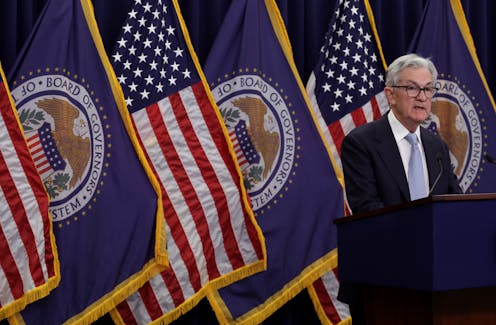Federal Reserve bows to bank-crisis fears with quarter-point rate hike, letting up a little in its fight against inflation
- Written by Jeffery S. Bredthauer, Associate Professor Of Finance, Banking and Real Estate,, University of Nebraska Omaha

The Federal Reserve raised interest rates by a quarter-point[1] on March 22, 2023, bowing to market expectations that it would temper its aggressive program of rate hikes amid a still-brewing banking crisis.
The U.S. central bank lifted rates to a range of 4.75% to 5%, its eighth straight increase[2] since March 2022. As late as early March 2023, it appeared that the Fed was planning to resume last year’s full-throttle rate-hiking campaign after slowing down in February. But the collapse of Silicon Valley Bank[3] on March 10 forced the central bank to take a step back.
So what does the Fed’s announcement tell us about where monetary policymakers think the economy – and inflation – are heading? A team of economists and finance scholars have weighed in to help make sense of it all.
Rate hike shows Fed confident in banking sector
Jeffery S. Bredthauer, University of Nebraska Omaha
This muted rate hike signals that the Fed is being cautious in order to steady the financial sector, which has been struggling since the collapse of Silicon Valley Bank[4] on March 10, 2023. But the fact that the Fed raised rates at all acknowledges that the fight against inflation will need to continue.
While still an increase, it’s more of a pause, in my view, because until the recent banking turmoil, the central bank was expected to lift rates by a half-point[5]. Inflation has remained stubbornly elevated[6] even though the Fed had jacked up rates 4.5 percentage points before the latest hike, and Chair Jerome Powell made it clear in congressional testimony[7] that he was intent on subduing the rise in prices.
But the aggressive rate rises left some regional banks like Silicon Valley Bank[8] vulnerable because they drove down the value[9] of tens of billions in assets they held. Silicon Valley failed because it didn’t have enough assets to meet withdrawals.
While the Fed and other regulators have acted to shore up[11] the system by backstopping depositors and smaller financial institutions, the concern now is that there may be more banks in a similar predicament. The smaller rate hike should help ease some of these concerns.
Yet, the inflation battle must go on, and the Fed recognizes that strong demand continues to prop up[12] consumer prices, particularly in the service sector. As such, I believe the Fed news shows that it has confidence in the banking system by continuing its interest rate hikes, albeit at a slower pace than had previously been expected.
And this is important. The greatest fear would be that spooked customers might irrationally start withdrawing money from banks because they fear a financial collapse – the classic bank run. That will not happen as long as there is faith in the banking system.
Drop in inflation gave Fed breathing room to ‘pause’
Joerg Bibow and Marketa Wolfe, Skidmore College
The Fed had two courses of action available when it came to setting rates. The first would have seen it continue aggressively raising rates, ignoring financial stability concerns – perhaps even seeing the hiking campaign as a sort of bloodletting that would squeeze inflation out of the economy. The second way forward would be to take a beat and see how the ongoing fragility in the banking sector[13] plays out first.
Fortunately – in our view – the Fed did not choose the former.
While falling short of a total pause in raising interest rates – an option some market watchers had been calling for[14] – the latest hike represents a substantial slowdown from the Fed’s previous plans, and therefore demonstrates the Fed’s caution in the face of a nascent banking situation.
It was able to do this in large part because there are clear signs inflation has come down.
As measured by the Personal Consumption Expenditure Price Index[15] – the Fed’s preferred measure[16] – inflation has declined from a 40-year high of 7%[17] in June 2022 to 5.4% in January 2023.
And the main cause of the recent surge in inflation[18] - COVID-19 supply chain disruptions – has eased. In addition, an upward wage-price spiral has not developed.
Furthermore, the banking turmoil might have already delivered an equivalent of another interest rate hike[19] in terms of its impact on the economy.
Although inflation remains high by historical standards, the risk of its reaccelerating seems low. Altogether, this allowed the Fed to take a breath and deal with what’s going on in the banking sector.
Put another way, the Fed decided, with so much uncertainty about the impact the recent turmoil will have on the economy, the risk of causing more damage was greater than the risk of inflation.
References
- ^ raised interest rates by a quarter-point (www.federalreserve.gov)
- ^ its eighth straight increase (www.federalreserve.gov)
- ^ collapse of Silicon Valley Bank (theconversation.com)
- ^ Silicon Valley Bank (www.cnbc.com)
- ^ was expected to lift rates by a half-point (www.cmegroup.com)
- ^ remained stubbornly elevated (www.bls.gov)
- ^ made it clear in congressional testimony (www.wsj.com)
- ^ left some regional banks like Silicon Valley Bank (theconversation.com)
- ^ drove down the value (www.fdic.gov)
- ^ Patrick T. Fallon/AFP via Getty Images (www.gettyimages.com)
- ^ have acted to shore up (www.washingtonpost.com)
- ^ strong demand continues to prop up (www.reuters.com)
- ^ ongoing fragility in the banking sector (apnews.com)
- ^ an option some market watchers had been calling for (www.wsj.com)
- ^ Personal Consumption Expenditure Price Index (www.bea.gov)
- ^ Fed’s preferred measure (www.stlouisfed.org)
- ^ 40-year high of 7% (fred.stlouisfed.org)
- ^ main cause of the recent surge in inflation (www.frbsf.org)
- ^ equivalent of another interest rate hike (www.nytimes.com)
Authors: Jeffery S. Bredthauer, Associate Professor Of Finance, Banking and Real Estate,, University of Nebraska Omaha

